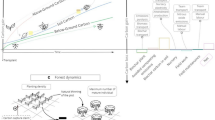Abstract
The forestry sector is being increasingly considered for abatement of greenhouse gases. A number of projects are likely to be implemented, particularly in tropical countries. It is essential to measure, record, and verify the carbon sequestered or emission avoided due to implementation of the forestry mitigation options. In this paper a set required parameters to be monitored for estimating carbon flows, monitoring methods, and institutional arrangements are presented along with a case study of the Western Ghat Forestry and Environment project.
Monitoring carbon flows in forestry sector projects is different due to a long gestation period and location- or site-specific variations in various parameters, particularly rates of C sequestration and emission. Parameters to be monitored include C sequestration in vegetation and soil, rates of wood extraction, wood use related emission, litter production, decomposition from litter, and soil. Methods include field vegetation monitoring, soil study, household and industry surveys, and laboratory investigation. Investigations, analysis, and report writing should be carried out using local educational institutions, NGOs, and consultancy firms. Verification could be taken care of by external agencies. Case studies of the Western Ghat Forestry and Environment project showed that less than 10% of the project budget may be adequate for intensive monitoring of carbon flows. The parameters to be monitored and methods required for any forestry mitigation project is nearly identical to that of any typical forest conservation or reforestation project.
Similar content being viewed by others
References
Brown, S., Sathaye, J., Cannell, M and Kauppi: 1996, ‘Mitigation of carbon emissions to the atmosphere by forest management’, The Commonwealth Forestry Review, 75(1), 80–92.
Forest Department: 1991, Western Ghats Forests and Environment Project, Final project document, Karnataka Forest Department, Bangalore.
IIPO: 1990, Report of the survival rate of trees, Indian Institute of Public Opinion, New Delhi.
PC: (1987), Social forestry programme: evaluation report, Programme Evaluation organization, New Delhi.
Ravindranath and Somashekhar: 1995, ‘Potential and economics of forestry options for carbon sequestration in India’, Biomass and Bioenergy, 8(5), 323–336.
Ravindranath, N. H. and Hall, D. O.: 1995, Biomass energy and environment — A developing country perspective from India, Oxford University Press, Oxford.
Ravindranath, N. H. and Hall, D. O.: 1996, ‘Estimates of feasible productivities of short rotation tropical forestry plantations’, Energy for Sustainable Development, 2(5), 14–20.
Seebauer, M.: 1992, Review of social forestry programmes in India, GWB Gessels Chaft Fur Walderhaltung Und Waldbewirtschaftung GMBH, Michelstadt, Germany.
Author information
Authors and Affiliations
Rights and permissions
About this article
Cite this article
Ravindranath, N.H., Bhat, P.R. Monitoring of Carbon Abatement in Forestry Projects — Case Study of Western Ghat Project. Mitigation and Adaptation Strategies for Global Change 2, 217–230 (1997). https://doi.org/10.1023/B:MITI.0000004478.13279.ca
Issue Date:
DOI: https://doi.org/10.1023/B:MITI.0000004478.13279.ca




